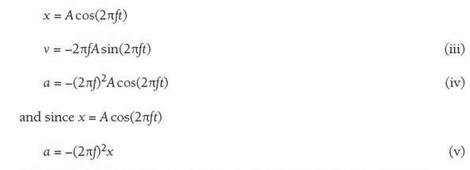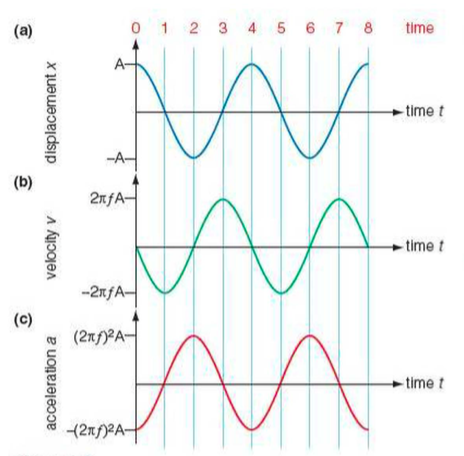Mathematical Description of SHM
Summary
⇒ The question we want to answer is this: how do the displacement, velocity, and acceleration of a simple harmonic oscillator vary with time?

⇒ This image gives us some insight
- Here a mass is oscillating up and down on a string
- The mass has been stroboscopically photographed by a camera, moving horizontally at a constant speed
- The shape of the curve we see is sinusoidal
Equations
⇒ The following graph shows how the displacement of the mass varies with time if it is released from rest with an amplitude A

⇒ The graph has the shape of a cosine function, which can be written as: x = Acosθ
⇒ But the value of θ is 2π after one complete cycle so, at the end of the cycle x = Acos(2π)
⇒ However, we know that the oscillation is a function of t. The function that fits the equation is:

- Where T is the time period for one oscillation. Remember that T = 1/f where f is the frequency of the oscillation
- This function solves the equation because after one oscillation t = T, so the inside of the bracket has the value 2π
⇒ Once we have an equation that connects displacement with time, we can also produce equations that link velocity with time, and then also acceleration with time

⇒ We derive this assuming x = A when t = 0
- However, the same equation would have been obtained whatever the starting condition
⇒ Mathematicians will see that the velocity equation is the derivative of the displacement equation, and that the acceleration equation is the derivative of the velocity equation
⇒ Since the maximum value of a sine or cosine function is 1, we can write the maximum values for x, v, and a as follows:

⇒ We also write down one further useful equation now, which allows us to calculate the velocity, v, of an oscillating particle at any displacement, x:

⇒ This will be proved later when we consider the energy of an oscillating system
The relationship between x, v, and a

⇒ This shows graphically the relationship between x, v, and a. These graphs are related to each other
⇒ The graph of velocity, v, against time, t, links to the gradient of the displacement-time graph (x-t) graph because v = Δx⁄Δt
- For example, at time 0, the gradient of the x-t graph (a) is zero, so the velocity is zero
- At time 1, the gradient of the x-t graph (a) is at its highest and is negative, so the velocity is at is maximum negative value
⇒ The graph of acceleration, a, against time, t, (c) links to the gradient of the velocity-time (v-t) graph (b) because a = Δv⁄Δt
- For example, at time 1, the gradient of the v-t graph (b) is zero, so the acceleration is zero
- At time 2, the gradient of the v-t graph (b) is positive and at its largest value, so the acceleration has its largest value
Examples

